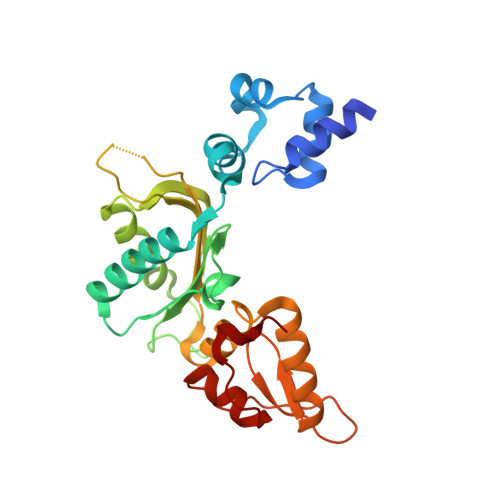A DNA polymerase beta mutator mutant with reduced nucleotide discrimination and increased protein stability
Shah, A.M., Conn, D.A., Li, S.-X., Capaldi, A., Jaeger, J., Sweasy, J.B.(2001) Biochemistry 40: 11372-11381
- PubMed: 11560485
- DOI: https://doi.org/10.1021/bi010755y
- Primary Citation of Related Structures:
1JN3 - PubMed Abstract:
DNA polymerase beta (pol beta) offers a simple system to examine the role of polymerase structure in the fidelity of DNA synthesis. In this study, the M282L variant of pol beta (M282Lbeta) was identified using an in vivo genetic screen. Met282, which does not contact the DNA template or the incoming deoxynucleoside triphosphate (dNTP) substrate, is located on alpha-helix N of pol beta. This mutant enzyme demonstrates increased mutagenesis in both in vivo and in vitro assays. M282Lbeta has a 7.5-fold higher mutation frequency than wild-type pol beta; M282Lbeta commits a variety of base substitution and frameshift errors. Transient-state kinetic methods were used to investigate the mechanism of intrinsic mutator activity of M282Lbeta. Results show an 11-fold decrease in dNTP substrate discrimination at the level of ground-state binding. However, during the protein conformational change and/or phosphodiester bond formation, the nucleotide discrimination is improved. X-ray crystallography was utilized to gain insights into the structural basis of the decreased DNA synthesis fidelity. Most of the structural changes are localized to site 282 and the surrounding region in the C-terminal part of the 31-kDa domain. Repositioning of mostly hydrophobic amino acid residues in the core of the C-terminal portion generates a protein with enhanced stability. The combination of structural and equilibrium unfolding data suggests that the mechanism of nucleotide discrimination is possibly affected by the compacting of the hydrophobic core around residue Leu282. Subsequent movement of an adjacent surface residue, Arg283, produces a slight increase in volume of the pocket that may accommodate the incoming correct base pair. The structural changes of M282Lbeta ultimately lead to an overall reduction in polymerase fidelity.
Organizational Affiliation:
Department of Therapeutic Radiology and Genetics, Yale University School of Medicine, New Haven, Connecticut 06520, USA.














